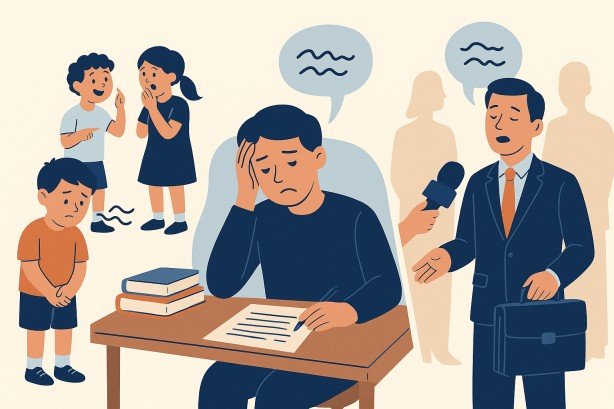There is a famous old story,
A woman who lived with both blindness and stammering was once asked: “Which is harder to live with?”
She said:
“Blindness is visible. People see it, they understand, and they don’t expect me to do what I cannot. But stammering is invisible until I speak. Then people judge me, misunderstand me, and assume I lack ability or confidence. Blindness is a disability, but stammering often isolates me even more.”
Below are the stages of life & challenges with stammering :
Childhood and School Years
- Early Learning Delays : Children who stammer may struggle with oral exams, basic introduction, making friends and class participation.
- Bullying and Teasing : Stammering often makes children targets for peer ridicule, which can damage self-esteem.
- Parent and Teacher Reactions : Overcorrection or pressure to “speak properly” may worsen anxiety and hinder natural speech development.
- Social Isolation : Many children avoid group activities or making friends to hide their speech difficulties.
Growing Up Years
- Identity and Confidence : During teenage years, self-image is very fragile. Stammering can make individuals feel “different” or less capable.
- Avoidance Behaviours : Teens may begin to avoid speaking in public, answering in class, or even using the phone.
- Emotional Strain : Fear of embarrassment can contribute to anxiety, depression, or withdrawal.
- Missed Opportunities : Debates, cultural events, and leadership roles are often skipped because of speaking anxiety.
Higher Education
- Classroom Participation : Oral presentations, viva exams, and group projects can feel overwhelming.
- Course Selection : Some may avoid courses or careers requiring high verbal communication.
- Peer Relationships : Difficulty in initiating conversations may limit social circles or networking opportunities.
- Self-Doubt : Students often underestimate their abilities, assuming stammering will block success.
Career and Workplace
- Interviews : Job interviews and campus placements are among the toughest hurdles for people who stammer.
- Workplace Communication : Meetings, client calls and presentations may be stressful, leading to avoidance or underperformance.
- Bias and Underestimation : Employers or colleagues may wrongly equate speech difficulty with lack of competence.
- Leadership Barriers : Opportunities for promotion, team management, or public-facing roles may be missed due to perceived limitations.
- Business and Entrepreneurship : Negotiations, networking, and pitching ideas can feel disproportionately difficult.
Personal and Social Life
- Family Dynamics : Parents who stammer may fear passing it on to children or feel inadequate in guiding them.
- Social Participation : Speaking at gatherings, making public announcements, or even small talk at events can trigger avoidance.
- Self-Image : Ongoing struggles may reinforce feelings of being “less capable,” impacting overall confidence.
Later Adulthood
- Career Plateau : Some remain in roles below their potential due to speech-related fears.
- Reduced Advocacy : Many avoid community leadership or public speaking even if they are knowledgeable.
- Cumulative Emotional Weight : Years of struggle may result in low self-worth, frustration, or regret over missed chances.
- Resilience in Some : Conversely, some individuals develop exceptional resilience, patience, and empathy due to their journey.
Misunderstanding and Humiliation
- Everyday Misunderstandings : People often wrongly assume a person who stammers is less intelligent, or even view them as rude, egoistic, problematic, timid, fearful or lacking capability – when in reality, stammering is only a speech difference and not a reflection of character, skills, confidence or capability.
- Negative Judgments: Some may wrongly equate stammering with low intelligence or lack of confidence.
- Mockery and Imitation: Children and even adults may mimic stammering, turning it into a source of ridicule.
Overall Problems :
- Educational Barriers : Hesitation in class, oral exams and presentations.
- Career Challenges : Interviews, workplace communication and leadership limitations.
- Social Struggles : Bullying, isolation, difficulty forming or maintaining relationships.
- Emotional Impact : Anxiety, low self-esteem, avoidance behaviours.
- Missed Opportunities : Avoidance of leadership, networking, and personal milestones.
- Misconceptions by Others: People who stammer are often misunderstood in terms of personality, character and Calibre.
- Cumulative Burden : A lifelong sense of “holding back” compared to one’s true potential.
From Struggle to Solution
I share all of this not just from observation, but from lived experience. I was once a severe stammerer myself and have personally faced every one of these challenges – misunderstanding, missed opportunities and the constant inner battle with confidence.
But here’s the truth: stammering does not define you. With the right knowledge, techniques and mindset, it can be managed to a level where it no longer holds you back from living fully.
That’s why I have dedicated years to researching speech, hearing, and neurosciences, and from this journey I have developed a set of practical solutions, life guides and tools. These are designed to help you not just overcome stammering and stuttering but for all related speech and communication challenges
Your journey may be difficult, but it is absolutely possible to rise above stammering. I did it and so can you. All the best!




 You can report directly via our Contact Form or email us at below emails.
You can report directly via our Contact Form or email us at below emails.